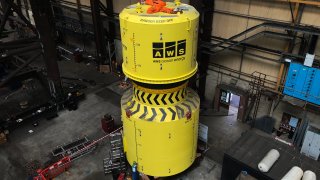
- Plan is to deploy and test the tech at the European Marine Energy Center in Orkney, an archipelago located north of mainland Scotland, later this year.
- The Archimedes Waveswing weighs 50 metric tons, has a diameter of 4-meters and stands 7-meters tall.
A project centered around the development of a subsea wave energy converter has taken another step forward after its two major constituent parts were joined together at a facility in Scotland.
According to a statement from AWS Ocean Energy on Wednesday, the assembly, which it described as "a critical milestone", took place last week. A "final hook-up" of internal systems is now taking place and commissioning and dry testing of the 16 kilowatt device, known as the Archimedes Waveswing, is expected to happen in early July.
The plan is to deploy and test the tech at the European Marine Energy Center in Orkney, an archipelago located north of mainland Scotland, later this year. The site for this testing will be in the sheltered waters of Scapa Flow.
Get top local stories in Southern California delivered to you every morning. >Sign up for NBC LA's News Headlines newsletter.
The Waveswing — which has been described as a "submerged wave power buoy" — weighs 50 metric tons, has a diameter of 4-meters and stands 7-meters tall. The device, AWS Ocean Energy says, "reacts to changes in sub-sea water pressure caused by passing waves and converts the resulting motion to electricity via a direct-drive generator."
Funding for the £3.4 million ($4.73 million) project has come from Wave Energy Scotland, which is itself funded by the Scottish government.
Money Report
The progress update on AWS Ocean Energy's device comes in the same month that another firm, Mocean Energy, said its Blue X wave machine — which is 20-meters long and weighs 38 metric tons — had started testing. Mocean Energy's testing is also taking place at EMEC's Scapa Flow site.
In a statement issued on June 14, Cameron McNatt, the firm's managing director, said: "In the Scapa testing phase, we will test power production, comparing results against our numerical predictions, and we will test operations including towing, installation, removal, and access at sea."
"The device is standalone and operated wirelessly," he added. "A 4G connection allows us to send commands and download data from shore."
Since its inception in 2003, EMEC has become a hub for the development of wave and tidal power, helping to put the U.K. at the heart of the planet's emerging marine energy sector.
A wide range of companies have undertaken testing at the site over the years. These include Scotland's Orbital Marine Power, which is working on what it describes as the world's most powerful tidal turbine, and Spain-based tidal power firm Magallanes Renovables.
There may be excitement in some quarters regarding the potential of marine energy, but its current footprint is tiny compared to other renewable technologies such as solar and wind.
Recent figures from Ocean Energy Europe show that only 260 kW of tidal stream capacity was added in Europe last year, while just 200 kW of wave energy was installed.
In comparison, 2020 saw 14.7 gigawatts of wind energy capacity installed in Europe, according to industry body WindEurope.






